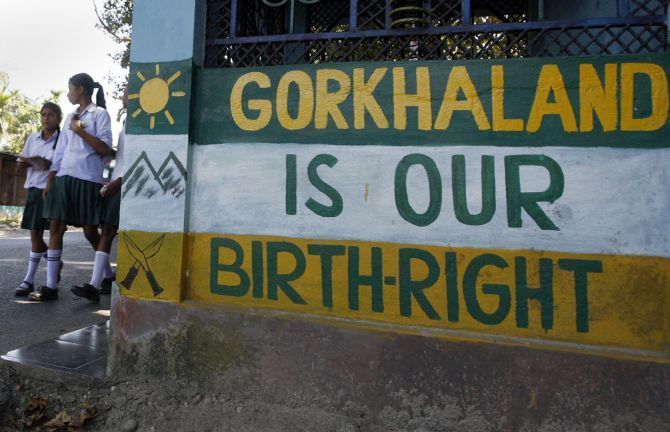While a group led by Binay Tamang wants to end the shutdown, the mainstream GJM, led by its supremo Bimal Gurung, wants the status quo to continue, reports Avishek Rakshit.

Factionalism, both within the Gorkha Janmukti Morcha, the largest party in the Darjeeling region, and other like-minded organisations, is taking the sting out of the movement for a separate state of Gorkhaland.
In June, after the West Bengal government attempted to make Bengali compulsory in the state’s schools, implying the decision would apply to schools in Darjeeling also, the GJM and other Gorkha parties opposed this on the grounds that the government was trying to “Bengalise” the region.
The upshot of this was the renewal of the movement for Gorkhaland, on which the state government and the Gorkha parties had met halfway in 2011, when the Gorkha Territorial Administration was formed, replacing the Darjeeling Gorkha Hill Council, formed in 1988.
The GJM has opted for a shutdown in the region. Mass rallies, blockades, picketing, attacks on the police and security forces, and burning effigies of Chief Minister Mamata Banerjee had been a regular feature in June.
However, as the shutdown is entering its 100th day this month, things are changing now, owing to factionalism.
A group led by Binay Tamang, ousted assistant general secretary of the GJM, and some other former GJM leaders wants to end the shutdown while the mainstream GJM, led by its supremo Bimal Gurung and other senior leaders such as Roshan Giri, Prakash Gurung, and Ashok Chettri, wants the status quo to continue.
A GJM leader is of the opinion that the party’s calculation was that if it could impose a blockade in the area, it would attract the Centre’s attention and, eventually, the Centre would askWest Bengal to accede to the demand for Gorkhaland.
Interestingly, Tamang’s change of heart followed his meeting with Banerjee at the state secretariat in late August.
Earlier, Tamang, who was also the party’s spokesperson, had supported the shutdown. Tamang says the shutdown hasn’t been able to achieve its objective and instead has made the people suffer.
As an immediate retaliation to this, the GJM ousted Tamang and his faction after they called off the shutdown without Gurung’s approval, but later, Gurung, through an audio message, asked Tamang to shun his path and return to the GJM fold.
A senior Gorkha politician of the region said Gurung’s reversal of position shows that his party’s support base is ebbing.
“Tamang has significant influence and commands a considerable base, particularly in the Kurseong sub-division. The GJM has realised that if Tamang is not in the party, it might lose that support base,” the politician said.
A second political leader said that popular figures opposing each other publicly and openly questioning the decision of the party’s leader are not good signals to the public.
Since June 15, after the police slapped charges on Gurung and others for escalating violence, the GJM supremo has gone missing. It is supposed that he is hiding near the West Bengal-Sikkim border.
During June-July, although Gurung maintained one-way communication with the hills’ residents through video and audio messages, Tamang, a popular leader, became the face of the party while Giri led the political delegation toNew Delhi.
“Now that the rift has become public, people are confused and don’t know if the shutdown has been able to achieve its purpose. Moreover, the pro-Gurung faction is trying to enforce the shutdown, forcing people to remain indoors,” the second leader said.
Several blasts have taken place, killing a civic volunteer, which led the police to press charges against prominent GJM leaders, including Gurung.
Some shops in the Kurseong and Mirik regions defied the GJM diktat and opened, but some of them downed their shutters again.
The state’s ruling party, the Trinamool Congress, and Tamang, have alleged that the GJM is forcing shops to remain closed.
Nevertheless, shops have reopened, this time in the Darjeeling railway station area, which is just a few kilometres from the heart of Darjeeling -- the centre of turmoil.
Factionalism is nothing new in Darjeeling.
The demand for a separate state was first raised in 1907 by the Hillmen’s Association of Darjeeling and was later taken up by the Gorkha National Liberation Front during the 1980s, when it took a violent turn, claiming 1,200 lives. Its leader, Subhash Ghising, became an overnight hero of the Gorkhas.
Later, Ghising came to terms with the state government, then run by the Left Front, settling for partial autonomy.
However, in 2007, Gurung overtook Ghising in popularity after accusing the latter of being hand in glove with the state government, and became the region’s firebrand.
In the meantime, another popular face, Madan Tamang, leader of the Akhil Bharatiya Gorkha League, was assassinated in 2010.
In 2016, Harka Bahadur Chhetri, who started his career in the GNLF and subsequently sided with Gurung, broke ranks with him.
Nevertheless, Gurung remains the most prominent of the Gorkha leaders and the GJM maintains its hold as the largest party.
“However, this time, Tamang’s departure will weaken the party and reinstate the GNLF as the largest party in Darjeeling,” a GNLF leader said.
As many as 15 parties are vying for power among a population of 132,016 people (the 2011 Census), of whom 85-90 per cent are of Nepali origin.











